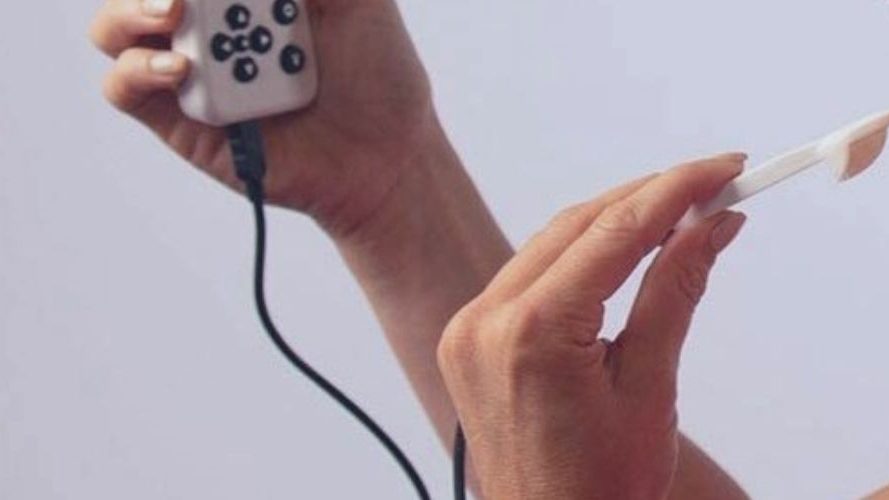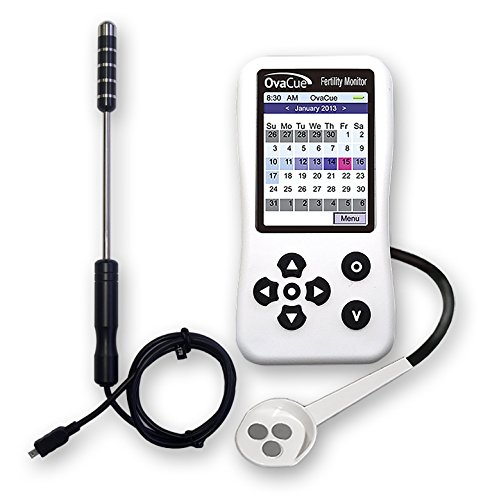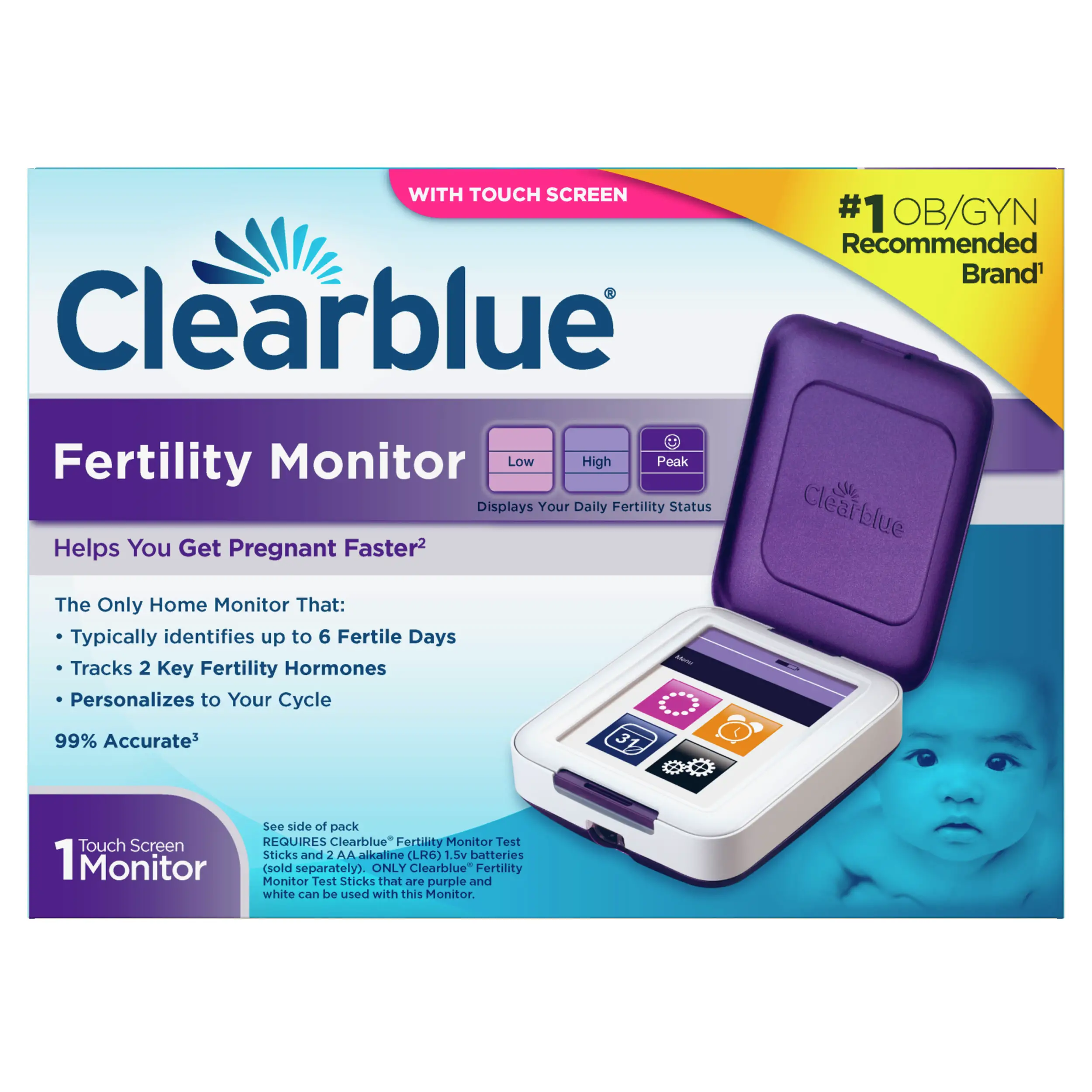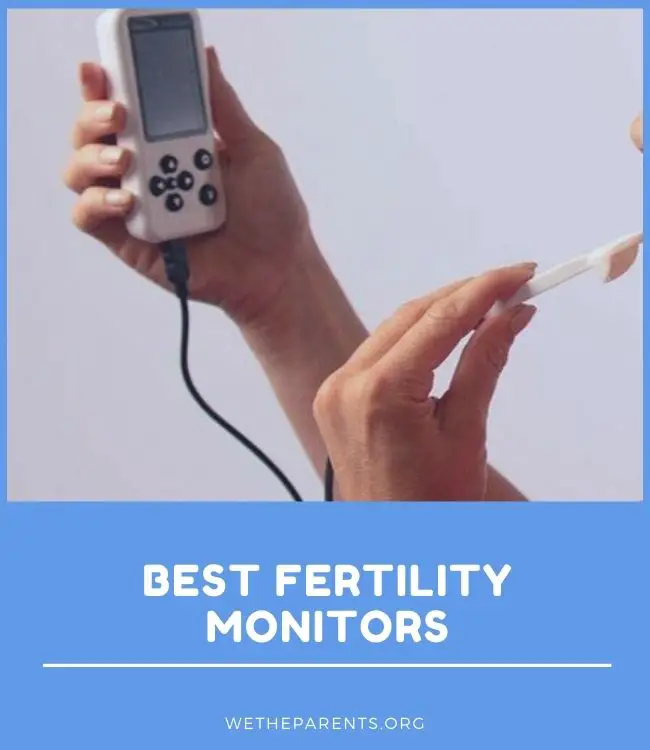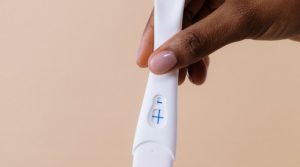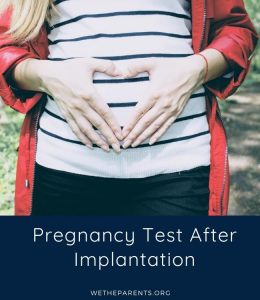For parents who are trying to conceive, the wait for that glorious positive test result can feel endless.
It’s no wonder, then, that many couples choose to use a fertility monitor to identify a mom’s fertile window, or the short period after ovulation during which pregnancy is possible.
There’s more than one way to monitor fertility, and the process is simple, non-invasive, and doesn’t disrupt intimacy.
A missed fertile window means another cycle of waiting to conceive, so let’s look at our favorite fertility monitoring options to figure out which is best for you.
In this article:
How does a fertility monitor work?
Though the term ‘fertility monitor’ technically refers to an oral and vaginal sensor, like the Ovacue, there are other ways to monitor your fertility and identify your peak conception window.
This gives you the option of using the method you find most comfortable and least invasive.
Temperature tracking
The tracking of basal body temperature, or that of a woman’s body while at rest, can act as a consistent predictor of ovulation.
This is true in that ovulation invariably causes a low, but consistent temperature spike, raising a woman’s body temperature from an average of 97 – 97.5 F to between 97.6 – 98.6 F.
The downside to this is that illness, poor sleep, and other factors, can sometimes impact basal body temperature, so some women may find this data difficult to interpret at first.
After a few months of data collection, personal patterns tend to reveal themselves more clearly. Basal body temperature should be taken every morning upon waking and before leaving bed for accurate results.
Some thermometers, like the Basal Thermometer on our list, sync results with an app, saving you the trouble of tracking and interpreting them.
While it’s a little more expensive than a standard digital thermometer, it can take almost all the effort out of this fertility monitoring method.
Hormonal urine test
Urine tests are an almost inevitable part of the pregnancy process. For those who find them quick and easy, a fertility monitor system that tracks the presence of fertility hormones in urine could be an ideal choice.
These monitors typically consist of a digital ‘reader’ device that lets you input your specimen and read information; plus external urine strips for specimen creation.
The purpose of the urine test is to identify raising levels of hormones, which indicate the beginning of your fertile period.
Though many ovulation predictors only test for the presence of luteinizing hormone, the Clearblue predictor kit on our list also tests for estrogen levels, increasing the accuracy and specificity of the results.
A urine monitor can assess your sample for LH and estrogen to identify your fertile days and also keep a backlog of data to establish your personal cycle.
There are pros and cons to this method, as it gives a more accurate indication of your peak fertility days than temperature monitoring, but also requires the ongoing use of test strips for urinalysis, which can be pricey.
Oral and/or vaginal sensor
These are fertility monitors in the truest sense of the word, using sensor wands to analyze the electrolyte levels of saliva or cervical mucus.
Both are impacted by the increase in estrogen that ovulation triggers [3], and they allow the monitor to provide more advanced notice of ovulation, as well as a more accurate prediction.
Though they feel a bit more ‘medical’ compared to urine tests or temperature monitoring, readings are taken quickly; whereas fertility monitors, like the OvaCue on our list, store data in an app for several months to establish accurate patterns before letting you refer back to previous months.
Because these are more complex machines that offer greater accuracy, they’re also the most expensive fertility monitoring option.
Do fertility monitors give accurate results?
Your choice of monitoring will impact the accuracy level of the results. While all fertility monitors offer potentially helpful data related to ovulation, the only way ovulation can be predicted with certainty is through the use of vaginal ultrasound.
The accuracy of temperature monitoring, for example, is highly dependent on the user. It requires consistent monitoring and a lack of external factors that can raise basal body temperature.
While many women have successfully become pregnant through temperature tracking, it’s not possible to offer a clear percentage of accuracy.
Urine monitoring offers a fairly clear picture of the changes happening inside the body and offers more definitive accuracy. The ClearBlue monitor on our list ranks at 73% accurate.
Oral and vaginal sensors are the most likely to offer accurate results; the OvaCue on our list boasting an impressive 98.3% accuracy rating.
These monitors also offer the most advanced notice of ovulation, allowing you to plan your intimacy accordingly.
Monitors that use an app to track data can help you to plan more accurately, as they can quantify and interpret your results in a technically correct way.
What factors may affect the outcome of my fertility monitor?
There are some situations where the results of your fertility monitor can be influenced by outside factors.
For women who choose basal body temperature monitoring as a means of ovulation tracking, the list of possible factors that can impact results is long. Here are some of the most common:
- Movement: BBT monitoring requires taking your temperature before you get out of bed. Even moving around defeats the purpose, so sit still until done with your reading.
- Insomnia: At least three consecutive hours of sleep are needed for an accurate basal body temperature reading, so work on your sleep hygiene and identify any obstacles to staying asleep through the night.
- Consistency: If your habits or job require you to keep different schedules on different days, this method may be difficult, as your basal body temperature may rise and fall at different times throughout the day, regardless of what you’re doing. Try to wake up and temp at the same time every day for optimum accuracy.
- Alcohol: Imbibing the night before your temperature check might up your morning BBT — but also might not. Once you track for a while, you’ll be able to tell whether or not booze is a factor in your readings.
- Environmental temperature: As logic follows, if you sleep in a room that’s exceptionally hot or cold, compared with what you’re used to, your basal body temperature will vary. If you get an unusual reading, chalk it up to the room temperature; if not, feel free to record it and proceed as normal.
- Jet lag: Even though travel is fun, it can also be hard on your body, causing temperatures to spike or dip. Temperature changes can affect your readings, while the overall stress of travel can also influence your ovulation.
If using an ovulation kit or traditional monitor to track your fertile window, the list of influential factors is shorter, but also more serious.
- Medical conditions: If you have PCOS, or other conditions affecting the ovarian follicles, hormone levels may peak prematurely and inaccurately.
- Prescriptions: If your doctor has prescribed a drug containing danazol, menotropins, or hCG, your readings may be inaccurate. This is also true of Clomid and most fertility medications.
- Pregnancy: If you’re pregnant now, or have recently had a baby, your readings will be affected.
What type of fertility monitor is right for me?
Each of these methods of fertility monitoring comes with advantages and disadvantages. Comparing the pros and cons side-by-side can be helpful in cementing your decision.
Temperature monitoring
Pros
- Inexpensive
- Simple, non-invasive
- No ongoing cost
Cons
- Hard to predict accuracy
- Many factors can affect results
Ovulation predictor
Pros
- Tracks actual hormone levels
- More accurate results
- Base cost is more affordable than a fertility monitor
Cons
- Test strips have ongoing cost
- Can be a little messy
Fertility monitor
Pros
- Highly accurate results
- Provides more notice of ovulation
- Tracks data over time to identify patterns
Cons
- Requires testing orally and vaginally twice daily
- Can be expensive
Ovulation tests: How to use and which one helped me get pregnant:
Our top picks of the best fertility monitors
Best overall
Our opinion
- Monitor style: Basal body temperature
- Price range: $
- Accuracy: User-determined
- Window before ovulation: Varies
- Saves and tracks data: Yes
Temperature tracking is one of the simplest ways to predict your ovulation window, but keeping track of the data — not to mention interpreting it — day to day, can be a big undertaking.
That’s where the Femometer Basal Thermometer (check price on Amazon) comes in handy. This convenient little device records your temperature data for you in the app, saving it over time to create a more accurate picture of your ovulation window.
Its temperature measurements are accurate to within 0.01 degrees Fahrenheit, and it uses intelligent analysis to piece together your fertility window, assisting with contraception, conception, and early monitoring of your pregnancy.
We love the Femometer’s convenience features compared to a standard thermometer. Turning on the device is as simple as taking off the cover, so there’s no struggling during those groggy, grumpy, early mornings.
Measuring your temperature takes less than a minute, so you’ll be off to the bathroom in no time.
Finally, its soft beep is perfect for leaving a sleeping partner undisturbed and, in the rare case of a very light sleeper, the sound can be reduced even further through the app, which receives data through Bluetooth connectivity.
What we love
- Turns on automatically when you remove the cap — your eyes don’t even need to be open
- It syncs with the Femometer app, allowing you to interpret your results
- Measurement is quick, and the soft beep won’t wake your sleeping partner
Watch for
- Some users have difficulty maintaining Bluetooth connectivity
Best for irregular cycles
Our opinion
- Monitor style: Oral/vaginal sensor
- Price range: $$$
- Accuracy: 98.3%
- Window before ovulation: 5 – 7 days
- Saves and tracks data: Yes
For parents who are trying to conceive and are looking for top-of-the-line equipment to help, the OvaCue Fertility Monitor (check price on eBay) is just what the doctor ordered.
This device uses both oral and vaginal sensors to detect the electrolytes present in saliva and cervical mucus.
In order to predict an ovulation window, the device uses the oral sensor to determine estrogen levels and indicate when fertility will occur.
Then, when the use of the vaginal sensor is introduced, the shift from estrogen to progesterone dominance in cervical mucus can be detected. This indicates that ovulation has occurred, meaning the fertility window is closed.
The accuracy levels of the OvaCue are hard to beat, and the detailed data it provides is ideal for helping women with an irregular cycle to interpret when they’ll be ovulating.
You’ll learn more about your unique cycle through consistent use of the device and may find it varies significantly from the ‘norm’. Unlike monitors that require long use of sensors, daily tests take only a few seconds, so they’re not invasive or time-consuming.
Another thing to love — even though the base cost is a little high, there’s no ongoing cost for test strips, which can become more costly if you don’t fall pregnant after the first few cycles.
Another justification for this expense is that the device can be used to avoid pregnancy when it’s time to begin contraception again, avoiding hormonal birth control.
What we love
- Predicts your ovulation window 5 to 7 days in advance, so it’s easier to plan around it
- An easy-to-use daily calendar view lets you track your cycle progression
- No test strips, so no ongoing costs
Watch for
- Some users find the unit a bit clunky
Best for PCOS
Our opinion
- Monitor style: Urine test
- Price range: $$
- Accuracy: 99%
- Window before ovulation: 1 – 5 days
- Saves and tracks data: Yes
The Clearblue name is one that’s trusted by both OB-GYNs and moms, and they do way more than conventional, digital pregnancy tests.
The Clearblue Fertility Monitor (check price on Walmart) is equally easy to use and read, using a handy, pocket-size touchscreen monitor to interpret urine samples taken on external sticks.
It sets itself apart from other ovulation prediction kits in several ways. Firstly, it helps women identify up to six fertile days, a larger window that better allows for intimacy planning.
Secondly, it tracks both the luteinizing hormone (LH) and estrogen, which offers a more accurate fertile window — in fact, this monitor is 99% accurate at detecting the LH surge.
It’s one of the best fertility monitors for storing your data over time, as it keeps up to six cycles’ worth of information, helping create the most personalized picture of your menstrual cycle possible.
Rather than syncing to an app, all data is viewable through the device’s touch screen, so there are no cables to keep track of or store.
There’s just one thing to note here, but it’s a biggie: test strips for this monitor are sold separately and are not reusable, so will account for an ongoing cost, so if you don’t fall pregnant in your first few cycles of use, the Clearblue Ovulation Test can wind up being one of the more expensive fertility monitors.
What we love
- Uses a clear, easy-to-use touchscreen interface
- Stores up to six cycles’ worth of data more than the other fertility monitors on our list
- Clearblue is the #1 recommended brand by OB-GYNs
Watch for
- This product uses test sticks which must be purchased separately and will be an ongoing cost
Best wearable
Our opinion
There’s no more thrilling feeling than wishing to carry and bring a life into the world! Nor a more heartbreaking one than realizing that conception that looks easy for others is such a hardship for you. This can turn a wonderful dream into a stress-filled challenge.
Sometimes the problem may simply be a poor understanding/knowledge of your body’s ovulation cycle. A good fertility monitor is the best way to track your fertile periods while indicating when you could possibly get pregnant.
That’s where the iFertracker (check price on Amazon) comes in handy. The iFertracker streamlines the aggravation of juggling your cycles and schedule in order to make your dream a reality.
This device is worn while you visit the Sandman. The rechargeable device automatically comes on after registering your body heat.
Wi-fi takes it from there, with Bluetooth connecting to a second mobile device. Get up in the morning, check your mobile device and get the scoop on how ready you are to seed.
You’re going to love what iFertracker does to relieve the stress of getting pregnant. And your partner’s going to love when you grab his hand and rush him to the bedroom to capture the moment!
What we love
- Easy-to-read colored graph simplifies menstrual cycle phases
- The app takes input of sexual activity, mood, etc., for gathering info
- You can map out cycle phases
Watch for
- To get an accurate BBT accounting, be sure to shut down your mobile device before activating the iFertracker, then turn on device in the morning for syncing
Best for budget
Our opinion
My closest friend suffers from PCOS. Her gyno told her that conception might not be easy, so she enlisted my help finding a fertility monitor. After extensive research, she opted for this product.
The Clearblue Fertility Monitor Touchscreen (check price on Amazon) made it easy for her and her husband to calculate the most likely days to expand their family.
Although she wasn’t thrilled about having to buy additional test strips, she agreed it was more than worth it for the eventual outcome. My goddaughter enters high school come fall…!
What we love
- Digitial touch screen for easy use
- Realiable, fast results
- Easily approachable for women with irregular cycles and/or PCOS
Watch for
- Test strips are sold separately
- At least four continuous weeks required for reliable results
- Peeing on the stick every morning
The bottom line
Although temperature tracking is more vulnerable to interference from external factors than ovulation predictors and fertility monitors, the cost and easy-to-use design more than justify checking it out before investing in something more costly and, potentially, unnecessary.
The Femometer (check price on Amazon), which was designed for women trying to conceive, levels up the concept by tracking, storing, and interpreting your data for you via Bluetooth connectivity — reading your results is as easy as opening up the app.
The simplicity and user-friendliness of the device can’t be beaten; just remove the cap and it automatically turns on.
It will take your temperature within 30 seconds, indicated by a soft beep designed to avoid waking a sleeping partner, and you can lower the volume even further through the app if desired.
For the price, the interface and results of this handy little device can’t be beat.


